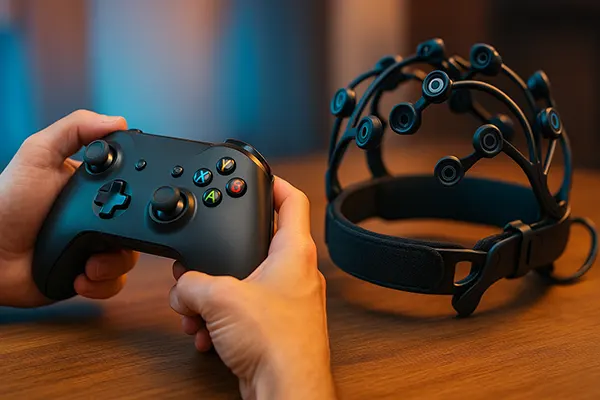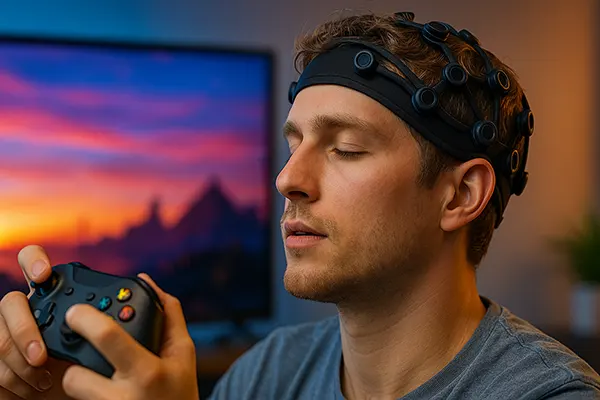
Evolution of Game Controllers: Ergonomics and Neurointerfaces in Focus
Over the past four decades, game controllers have undergone a dramatic transformation. From the simple, square designs of early consoles to the adaptive, sensor-laden tools of today, this evolution reflects the industry’s commitment to improving user experience, precision, and immersion. In 2025, ergonomics and neurotechnologies play a central role in the development of game input devices.
From Digital Buttons to Intelligent Feedback
The earliest controllers were purely digital, offering limited input and minimal comfort. The NES controller, released in the 1980s, was rectangular and stiff — functionality took precedence over comfort. Over time, manufacturers shifted to rounded forms, introducing analogue sticks and shoulder buttons with the PlayStation and Xbox generations.
In the 2010s, haptic feedback and motion sensors became key. Sony’s DualShock 4 and Nintendo’s Joy-Con introduced vibration technology capable of mimicking in-game sensations. These features improved immersion, allowing players to “feel” events like car collisions or gunfire.
In 2025, adaptive triggers, pressure-sensitive buttons, and gyroscopic sensors are standard. The latest controllers not only respond to input but actively guide it — increasing trigger resistance in racing games or offering fine vibration patterns in stealth sequences.
Ergonomics as a Design Standard
Controller ergonomics is no longer a secondary concern. Major manufacturers now invest heavily in anthropometric studies, ensuring their products suit a wide range of hand sizes and grip styles. This approach reduces strain and prevents long-term wrist injuries among frequent users.
Designs are now sculpted for natural finger placement, with textures and weight distribution refined for hours of uninterrupted use. This is especially vital in competitive gaming, where milliseconds count and fatigue is unacceptable.
Customisable features have also become essential. Controllers offer interchangeable parts — thumbsticks, back paddles, and even entire grips — to accommodate personal preferences and improve performance.
The Rise of Neurointerfaces in Gaming
As of 2025, brain-computer interfaces (BCIs) have moved from labs to living rooms. Companies like Valve and NextMind have experimented with devices that interpret brain signals, allowing users to perform simple commands without touching a button.
While still in the early stages, these technologies are increasingly relevant. Current consumer-grade BCIs enable users to control game menus or camera angles with focused attention, enhancing accessibility for players with mobility impairments.
Game developers are beginning to integrate support for BCI-based interactions in experimental titles, particularly in VR settings. Although not yet a full replacement for traditional controllers, neurointerfaces signal a shift toward hands-free, cognitive gameplay.
Challenges of Neurotechnology Integration
Despite their potential, neurointerfaces face technical and ethical challenges. Accuracy remains a hurdle — consumer EEG devices can struggle to differentiate subtle mental commands in real-time environments. Lag and misinterpretation may disrupt gameplay rather than enhance it.
Privacy is another concern. Devices that read neural patterns may inadvertently collect sensitive information, requiring clear data handling standards. Developers and hardware manufacturers must adopt transparent privacy policies and implement localised data processing.
Accessibility and cost also play a role. Many current neurointerface devices are still expensive and require setup knowledge. For broader adoption, products must become plug-and-play, affordable, and compatible with mainstream systems.

Adaptive Future: What Lies Ahead
Looking forward, hybrid controllers will dominate the market — combining tactile inputs, biometric feedback, and neural data to create highly personalised user experiences. These tools will not just read commands but anticipate intent through real-time monitoring.
Biometric sensors, such as heart rate and skin conductivity monitors, already help games adjust difficulty or narrative tone based on player stress levels. Integrating this with brainwave monitoring could create emotionally responsive games that adapt in complexity or pace.
Such adaptability enhances player engagement and offers new design opportunities. Developers could craft dynamic experiences tailored to user emotions, attention, and fatigue, increasing both immersion and enjoyment.
Conclusion: Human-Centric Innovation
The evolution of game controllers reflects a broader shift in design philosophy: prioritising user comfort, accessibility, and immersion. In 2025, controllers are no longer passive tools — they are extensions of the player’s body and mind.
With continued innovation in ergonomics and neurotechnology, the boundary between thought and action in games is steadily eroding. Future generations of controllers may very well respond to emotion and intent as naturally as they do to thumbs and fingers.
As the industry balances performance with inclusivity and cognitive input, game controllers will evolve beyond hardware — becoming adaptive companions in the player’s journey through virtual worlds.


